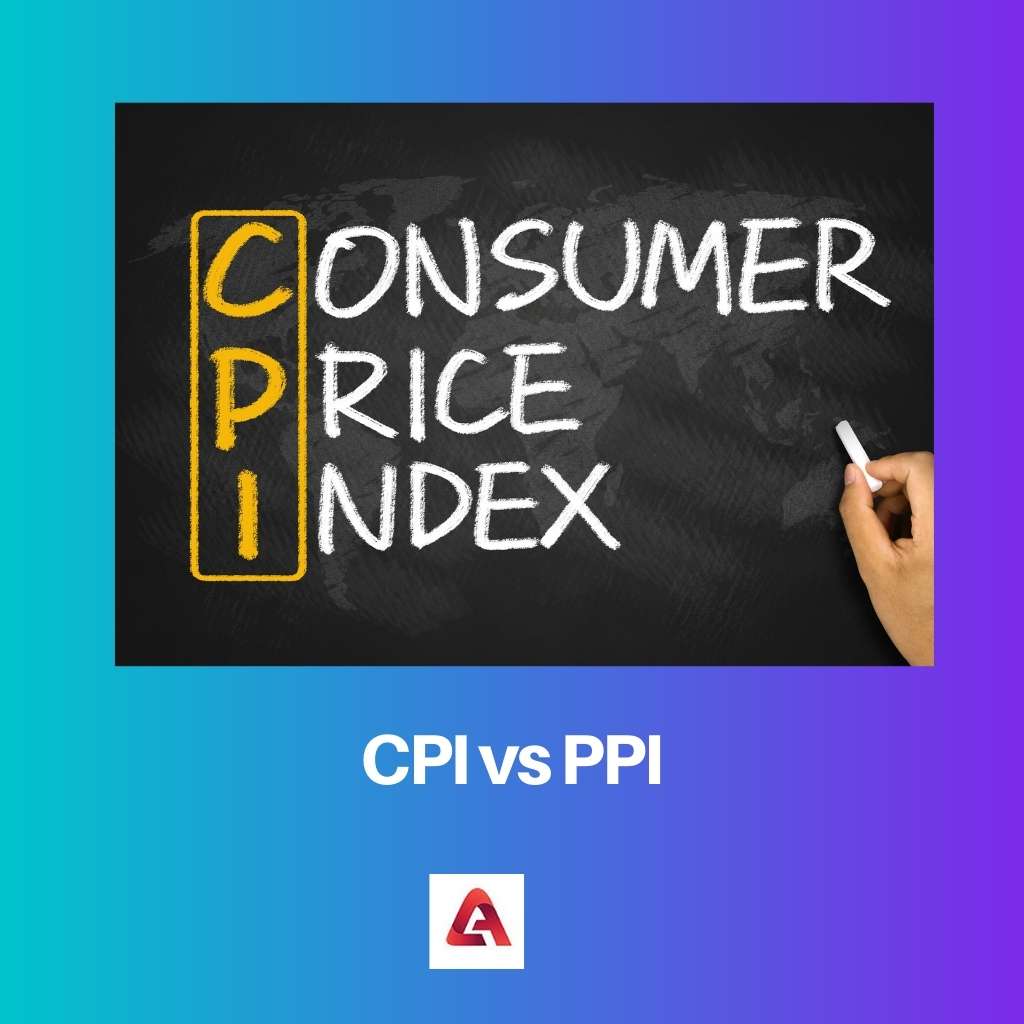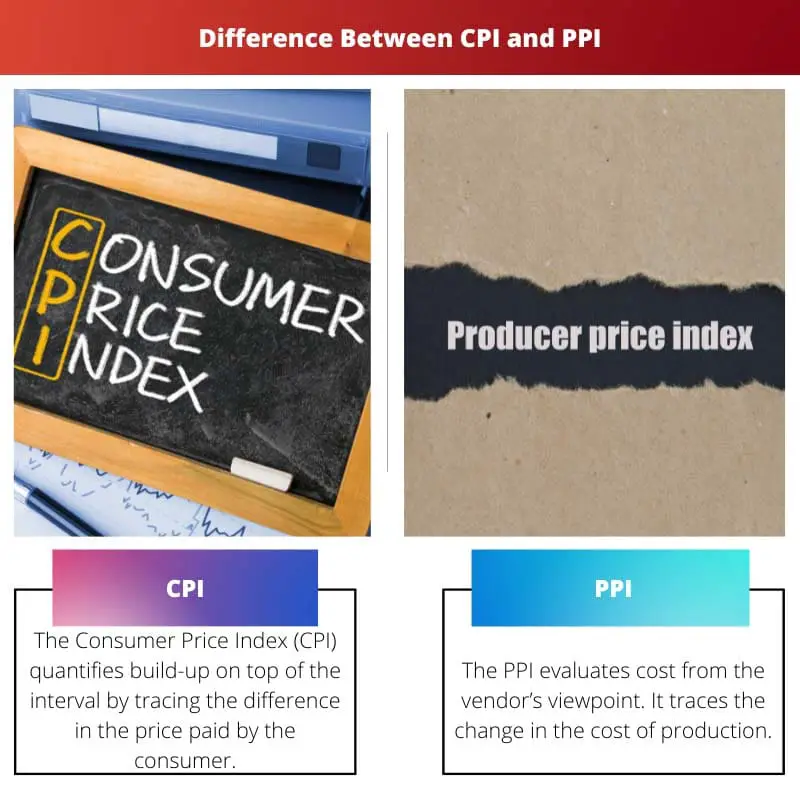The change in price affects one and all. It could be a change in the customary consumer goods or any highly-priced fixed asset which affects the interest rate.
The inflation-related data CPI and PPI indicate economic concerns like purchasing power and the Gross Domestic Product (GDP) and are crucial data for an individual, investor, or a country.
Key Takeaways
- CPI (Consumer Price Index) measures changes in the prices of goods and services consumed by households, while PPI (Producer Price Index) measures changes in the prices of goods and services purchased by businesses.
- CPI is used to track inflation and the cost of living, while PPI is used to measure changes in the cost of production.
- CPI is based on a fixed basket of goods and services, while PPI is based on the prices of goods and services at different stages of production.
CPI vs PPI
CPI measures the overall change in consumer prices and only includes components of personal consumption directly paid for by the consumer. PPI measures the change in prices received by domestic producers for their goods and services and includes personal consumption components not paid for by the consumer.

The CPI (Consumer Price Index) computes the difference in the evaluation reimbursed by the consumer over a time frame for specific commodities and resources. These commodities and resources get classified into edible and drinks, accommodation, clothing, shipment, pharmaceutical safe keeping, restoration, teaching, and reporting.
It reflects the cost of living of any specific region.
The PPI is the price movement from the retailer’s perspective. It identifies the change in the cost of production.
The PPI data utilization is for manufacturing, material, and appreciation product-formed concluding and transitional requests. This data consists of all the industries, to name a few agriculture, manufacturing, mining.
Comparison Table
| Parameters Of Comparison | CPI | PPI |
|---|---|---|
| Meaning | Inflation rate | The price is obtained by the producer. |
| Coverage | Goods and services. | Capital equipment and consumer goods. |
| Amount | The total amount collected. | Taxes are not considered. |
| Utility | Income and expenditure. | Revenue and output. |
| Date and consideration | 18 days for CPI. | A specific date is taken into consideration. |
What is CPI?
The Consumer Price Index (CPI) quantifies build-up on top of the interval by tracing the difference in the price paid by the consumer. Inflation indicates that prices are increasing.
Additional money gets spent on the same goods or services compared to the previous year.
There is a cluster of goods and services considered for calculating CPI. There is a base year taken into consideration for calculating CPI and the broadly categorized group.
The change in CPI reflects the cost of living and intervals of growth or diminishing returns.
The formula used to calculate the CPI (Consumer Price Index) is as follows:
- CPI= Asking price of the retail container in the specified period of time (Split by) price of the retail container in the Foundation Year multiplied by 100.
The Base years get determined by the Labour statistics. The CPI measures the variation in the retail price but does not include savings and investments.
The change in CPI reflects price change in the economy, and when there is a rise in the CPI, it indicates an increase in the price. This increase implies a switch or adjustment to the amount of income.
This operation gets cited as classification.
What gets covered in the CPI:
In the statistics of the CPI Professionals, self-employed and unemployed people and retired personal get considered. Non-metros, rural population, people related to the farm, armed forces, and even patients in the asylum do not get covered in the CPI.
Economist and CPI:
The CPI index gets considered to gauge inflation. Since the technique of calculating CPI has changed over the years, economists believe it is not an authentic way to measure inflation.
The economist argues the CPI lags in giving a concrete understanding of the current inflation rate. There are newer methods that consider the price change, but even the quality of goods and the substitution.

What is PPI?
The PPI evaluates cost from the vendor’s viewpoint. It traces the change in the cost of production.
The data from the areas get utilized by the Labor census. The Labor census releases information on more than 10,000 products.
This data covers maximum industries, like constructions, agriculture, manufacturing.
The measurement of the commodity category or the single merchandise kind starts with a foundation interval. A base period gets used as a benchmark for data analysis.
The data accumulated gets interpreted keeping the base period in mind. The increase or decrease in the production gets compared to the base period.
Bureau of Labor Statistics Released Data of PPI:
The BLU is divided into three broad categories:
- Industry Level Classification- This determines the industry’s production costs. It determines the price paid to the industry depending on the output of the particular sector.
- Commodity Classification- This grouping of commodities and services is based on product similarities. The indicator is divided into three categories: finished, besides, and activities of commodities.
- Final and Intermediate Demands Based on Commodities (FD-ID)- The utility of the commodities, services, or construction is used to split them into subgroups. Final Desire (FD) or Interim Desire (ID) are the two types of end-users (ID). This classification takes into account the physical and processing characteristics of items.

Main Differences Between CPI and PPI
- CPI indicates the general level of inflation. PPI specifies the price obtained by the producer for their output.
- The CPI covers many goods and services. The PPI comprises specifically capital equipment and consumer goods.
- The total price collected is part of CPI. The taxes are not taken into account while calculating PPI.
- The CPI considers the price of all the eighteen working days of the month. The PPI takes into account the cost of goods on a specific date.
- The CPI gets utilized for adjusting income and expenditure. The PPI helps to understand revenue and measure the output.

